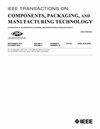用于电力电子器件低孔隙率铜膜的增强型抗氧化铜基导电油墨
IF 3
3区 工程技术
Q2 ENGINEERING, ELECTRICAL & ELECTRONIC
IEEE Transactions on Components, Packaging and Manufacturing Technology
Pub Date : 2024-06-20
DOI:10.1109/TCPMT.2024.3417261
引用次数: 0
摘要
铜基导电油墨因其烧结温度低、抗氧化性强而被广泛用于各种电气设备的研究。然而,铜(Cu)不稳定的氧化特性限制了其实际应用。现有的铜烧结抗氧化方法往往会降低铜的强度和可靠性。因此,本研究提出了一种新型铜复合油墨,由铜前驱体、铜微粒、有机保护剂和抗氧化剂组成。烧结过程非常简单,只需在 300~^{\circ }$ C 的氮气环境中进行 20 分钟的烧结,无需额外加压。因此,使用铜微粒和前驱体的混合墨水成功获得了氧化率仅为 3.21 wt% 的烧结铜。由于协同效应,烧结铜的孔隙率为 10.69%,比使用纯铜前驱体油墨烧结的铜降低了 71.77%。此外,该研究还讨论和分析了铜烧结过程中铜颗粒及其前驱体的晶格生长机制和协同机制。本文章由计算机程序翻译,如有差异,请以英文原文为准。
Enhanced Anti-Oxidation Copper-Based Conductive Inks for Low Porosity Copper Films in Power Electronics
Copper-based conductive inks have been extensively researched due to their low sintering temperature and high anti-oxidation properties for various electrical devices. However, the unstable oxidation properties of copper (Cu) limit its practical application. The existing anti-oxidation methods adopted in copper sintering often reduce copper strength and reliability. Therefore, the study presents a novel copper composite ink comprising copper precursors, copper microparticles, organic protective agents, and antioxidants. The sintering process is simple, requiring only 20 min at
$300~^{\circ }$
C in nitrogen without any additional pressure. As a result, sintered copper with an oxidation rate of only 3.21 wt% was successfully obtained using the mixed ink of copper particles and precursors. The porosity of the sintered copper is 10.69%, which is a 71.77% reduction compared to the copper sintered by using pure copper precursor ink, due to the synergistic effect. Furthermore, the study discusses and analyzes the lattice growth mechanism and synergy mechanism of copper particles and their precursors during copper sintering.
求助全文
通过发布文献求助,成功后即可免费获取论文全文。
去求助
来源期刊

IEEE Transactions on Components, Packaging and Manufacturing Technology
ENGINEERING, MANUFACTURING-ENGINEERING, ELECTRICAL & ELECTRONIC
CiteScore
4.70
自引率
13.60%
发文量
203
审稿时长
3 months
期刊介绍:
IEEE Transactions on Components, Packaging, and Manufacturing Technology publishes research and application articles on modeling, design, building blocks, technical infrastructure, and analysis underpinning electronic, photonic and MEMS packaging, in addition to new developments in passive components, electrical contacts and connectors, thermal management, and device reliability; as well as the manufacture of electronics parts and assemblies, with broad coverage of design, factory modeling, assembly methods, quality, product robustness, and design-for-environment.
 求助内容:
求助内容: 应助结果提醒方式:
应助结果提醒方式:


